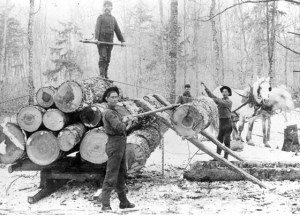From Hungry Rats:
It all comes down to money, that money coursing in from Flint and Saginaw and Detroit. “Bring us lumber!” they bellowed. “Bring us lumber, and don’t trouble to worry for the welfare of those shanty boys, whether they work an honest day or lop the ends off the logs. The only thing is wood, wood, and bring it fast.” The trains ran in and out and the forests vanished. The people became enraged with us because they were a poor folk in a country of stumps, while we still took in our hundreds of dollars. Yet we paid out hundreds of dollars.
One of the most exciting parts of the Hungry Rats project was researching and writing about Michigan’s lumber era, a crucial facet of the Westward expansion that generated more capital than any American gold rush, and without which the auto industry would certainly have bypassed Detroit.
19th century Michigan had much more in common with the Old West than with its Great Lakes neighbors, and like the West, the “romantic” trappings of this time (from gunslingers and saloons to Indian camps and brothels) really existed in an environment of lawlessness, aggressive commerce, and the exploitation of immigrants and native peoples.
Lumber-era Michigan was, quite simply, a frontier that expanded faster than the growth of more “civilized” institutions. Set apart from its neighbors by the lakes, the waterways also provided a means for transporting huge stocks of lumber needed for a country exploding in population. In this it also abetted the rise of Chicago and the rapidity of Western settlement. Michigan was clear-cut from the 1860s to the 1890s, and grew from a cold and neglected outpost to the center of industrial enterprise in the U.S.
The middle third of Hungry Rats concerns itself with two historical serial killers based out of Clare County. They acted with near impunity and one of them earned the moniker “the devil of Hell.” But there are many real characters from the weird half-century that saw the logging-off of North America’s most extensive forestland. P.K. Small, the Ogre of Seney, was known for eating anything and everything in sight, Warren Bordwell’s Saginaw brothel masqueraded as an opera house, and Dan Seavey was a Lake Michigan pirate who escaped from jail in Chicago and commandeered a ship. The infamous Catacombs of Bay City would have given New York’s Five Points district a run for its money.
If Hungry Rats enjoys any success at all, I hope that it encourages a closer look at this compelling and vital phase of American history. Michiganders, especially, should know this stuff; it is significant, and just as importantly, it makes for great reading. I’ve provided a few links below, but (in keeping with the slight obscurity of this era) most research hasn’t made the leap to the internet. I’m happy to provide a Bibliography upon request. Some great books on the subject (almost entirely out-of-print) can be gotten cheaply through Amazon.
Dan Seavey, the Lake Michigan Pirate: http://www.classicwisconsin.com/features/ourpirate.htm
Nellie Bly, a journalist, went to Seney, Michigan’s own Deadwood. Lots of good stuff here: http://wildwoodpress.org/a-shadowy-saga-of-seney/
Some sites on the lumber era in general:
http://www.americanheritage.com/articles/magazine/ah/1976/3/1976_3_4.shtml
http://seekingmichigan.org/look/2010/01/12/logging-camp
http://www.michiganepic.org/lumbering/lumbering.html
http://www.classroomhelp.com/lessons/michigan/lumber7.html
